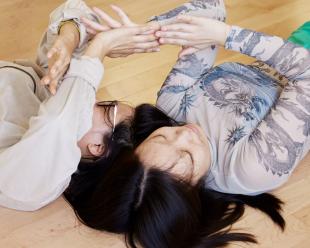Women’s Touch 4th ed.: Refining Nonverbal Communication in Contact Improvisation

After a very successful and fully booked Women's Touch event on Mother's Day last March, there was a clear demand for another workshop.
This fourth edition focuses on exploring the intersections between Laban Movement Analysis and Contact Improvisation.
What is Women's Touch?
Women’s touch is an event curated by Marie Chabert, that offers a space for those who identify as women and non-binary to explore movement practices that are mainly based on touch (Contact Improvisation, somatic practices, improvisation) in a safe environment. It aims to empower women to claim their space and redefine it within a framework that challenges prevailing patriarchal norms. It offers both a place to embody and share our experiences verbally.
Our intention to foster a safe and supportive environment, where women and non-binary participants feel safe to take risks, be vulnerable, and share their humanity, free from the pressure of dominant dynamics.
Cultivating such spaces requires trust, shared language, and mutual care. It allows us not just to survive, but to thrive in connection.
Who is this for?
Those who identify as women and non-binary, whether you have taken part in the first workshop or not you are welcome.
It welcomes all levels and can be applied to other practices than Contact Improvisation.
What is the content?
We cover material from Laban Movement Analysis to give us tools that are both theoretical and embodied in order to feel confident being in and out of touch.
We will cover concepts such as Relationship structure and the 2 Motion factors of Space and Time. We will have time to reflect, share with others, explore various qualities and structures in our dance, in solo, with a partner and with the whole group in a jam.
Sharing open to all genders
We will have an informal sharing at the end of the workshop with a Q&A. The idea is to share the research and the findings with others, with the wish to create safer spaces in Contact Improvisation and other embodied touch based practices. The sharing will be open to all genders.
What is Laban Movement Analysis?
Developed by Rudolf Laban, a choreographer, dancer, and movement theorist, Laban Movement Analysis is a comprehensive system for observing, describing, and interpreting human movement.
Claudia Richli will introduce us to concepts focusing on how movement affects interpersonal dynamics. We will explore the Structural Model of Human Movement which offers a comprehensive and accessible framework for understanding and analysing movement. We will particularly focus on the relationship structure and dynamic structure.
Relationship Structure: We will examine different ways of interrelating through movement—such as different types of touch and proximity without contact—to develop greater awareness of how physical interaction influences perception and communication.
Dynamic Structure: The “how” of movement—the quality or impulse behind it—reveals the mover's intentions, moods, or emotional states. We'll explore how movement qualities affect both the dancer's experience and the interpretation by others.
By reflecting on the diversity of sensations while dancing in different dynamics, dancers will understand that how they feel may differ from how their partner perceives the interaction.
Through this training, dancers will refine their ability to navigate nonverbal communication with greater consciousness, fostering more respectful and mindful physical engagements in contact improvisation.
Schedule (may slightly change)
10-10.30am: arrival, tea and intro in the kitchen/lounge area
10.30am-1.30pm group agreement and workshop facilitated by Claudia Richli in the research studio (includes writing and sharing)
1.30-2.30pm: lunch break (food sharing)
2.30-3pm: Contact Jam
3-4pm: Informal sharing with Q&A facilitated by Marie Chabert in the rooftop studio